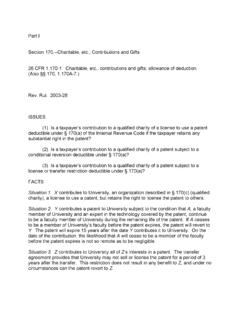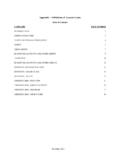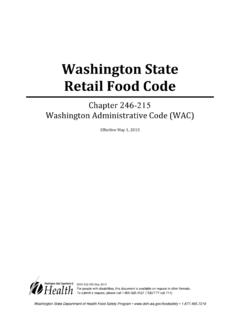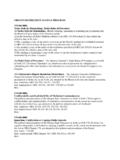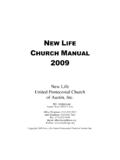Transcription of QUALIFYING FOR PUBLIC CHARITY STATUS: and the Section …
1 QUALIFYING FOR PUBLIC CHARITY status : The Section 170(b)(1)(A)(vi) and 509(a)(1) Test and the Section 509(a)(2) Test Tax-exempt status under Section 501(c)(3) of the internal revenue code permits a charitable organization to pay no tax on any operating surplus it may have at the end of a year, and it permits donors to claim a charitable deduction for their contributions. There is a further division in the world of Section 501(c)(3) organizations, classifying them into private foundations and PUBLIC charities. A special regulatory scheme applies to private foundations in addition to the basic rules governing all charities. The private foundation laws impose a 2 percent tax on investment income, limit self-dealing and business holdings, require annual distributions, prohibit lobbying entirely, and restrict the organization's operations in other ways.
2 Also, large donors to a private foundation have a lower ceiling on the amount of deductible gifts they can claim each year. In most circumstances, PUBLIC CHARITY status is preferable to private foundation status . A Section 501(c)(3) organization can avoid private foundation status , and thus be classified as a PUBLIC CHARITY , in any of three ways: (1) by being a certain kind of institution, such as a church, school, or hospital; (2) by meeting one of two mathematical PUBLIC support tests; or (3) by QUALIFYING as a supporting organization to another PUBLIC CHARITY . In this memo, we discuss the two mathematical PUBLIC support tests. The PUBLIC /Governmental Support Test of Sections 170(b)(1)(A)(vi) and 509(a)(1) This PUBLIC support test was designed for charities which derive a significant proportion of their revenues from donations from the PUBLIC , including foundation grants, and from governmental grants.
3 The test has two variations. If an organization can satisfy either of the two variations of this support test, it will qualify as a PUBLIC CHARITY under Sections 170(b)(1)(A)(vi) and 509(a)(1). The first variation is known as the one-third test. A CHARITY can satisfy this test if PUBLIC support is one-third or more of the total support figure. Nothing more is needed if this mathematical fraction is attained. The second variation, known as the 10 percent facts and circumstances test, has two requirements. First, the CHARITY 's PUBLIC support must be at least 10 percent of its total support. Second, the CHARITY must demonstrate, with reference to facts and circumstances specified by the IRS, that it is operated more like a PUBLIC CHARITY than like a private foundation.
4 -2- In order to determine which test applies to your organization, you must begin with the mathematical PUBLIC support computation. The first step in that computation is to determine two figures: total support and PUBLIC These figures are, respectively, the denominator and the numerator of the PUBLIC support fraction. They are computed with reference to the CHARITY 's revenues over a specific measuring period, which is usually four years in length; in the case of newly formed organizations, the measuring period is five In both instances, however, the figures are based on the revenues for the entire period.
5 It is not a year-by-year calculation. 1. Total support (support base, denominator). To determine the CHARITY 's support base, which is the denominator of the fraction, we add the following revenue items for the measuring period: Gifts, grants,3 contributions, and membership fees received. Gross investment income ( , interest, dividends, rents, royalties, but not gains from sale of capital assets). Taxable income from unrelated business activities,4 less the amount of any tax imposed on such income. Benefits from tax revenues received by the CHARITY , and any services or facilities furnished by the government to the CHARITY without charge, other than those generally provided to the PUBLIC without charge.
6 1 As we will explain in the second part of this memo, the definitions of total support and PUBLIC support are different under Section 509(a)(2). 2 When an advance ruling period is involved, the PUBLIC support tests are reviewed over a five-year period. After the advance ruling period, the support tests are measured on an ongoing basis over a rolling four-year period. If the tests are satisfied over a particular four-year period, then the organization qualifies as a PUBLIC CHARITY for the next two years. For example, if a CHARITY satisfies the support tests for the four years from 1988 through 1991, it will be treated as a PUBLIC CHARITY for 1992 and 1993.
7 The tests are then applied again to the four years from 1989 through 1992 to determine how the CHARITY should be classified for 1994. 3 In some limited circumstances, an unexpectedly large grant may be excluded from both PUBLIC support tests as an "unusual grant" described in Regulation (e)(6). These technical rules are beyond the scope of this memorandum. 4 Exempt organizations are generally subject to tax, at corporate rates, on their income from a trade or business which is regularly carried on, the conduct of which is not directly and causally related to the accomplishment of the organization's exempt purposes. There are a number of exceptions to this rule, notably for passive investment income.
8 See internal revenue code Sections 511-514 and the accompanying Regulations. -3- All other revenues, except for: -- Gains from the sale of capital assets. -- Gross receipts from admissions, merchandise sold or services per-formed, furnishing of facilities, or other business activities related to the CHARITY 's exempt purposes. -- Unusual grants, as defined by the IRS. 2. PUBLIC support (numerator). The numerator of the fraction consists of that portion of total support which falls within the following defined classes of revenue : Government grants (not fee-for-service contracts) are included in full.
9 Gifts, grants, contributions, and membership fees from other PUBLIC charities qualified under 170(b)(1)(A)(vi) are included in full. Gifts, grants, contributions, and membership fees from all other sources are counted in full, so long as the amount from each source does not exceed 2 percent of total support -- that is, 2 percent of the denominator. Larger gifts, grants, contributions, and membership fees may be counted up to 2 percent of the total support figure, but no more. Any amounts above that figure are not counted as PUBLIC support. Note: When applying the 2 percent limit, amounts from certain related family members, and from businesses and their major owners, are combined and treated as coming from one source.
10 Benefits from tax revenues received by the CHARITY , and any services or facilities furnished by the government to the CHARITY without charge, other than those generally provided to the PUBLIC without charge. 3. The one-third test. If the PUBLIC support figure is one-third or more of the total support figure, when the two are combined in a fraction, the organization will qualify automatically as a PUBLIC CHARITY . 4. The 10 percent facts and circumstances test. If the PUBLIC support fraction is less than one-third but more than one-tenth, the organization turns to the alternate PUBLIC support test for donor-supported charities.

